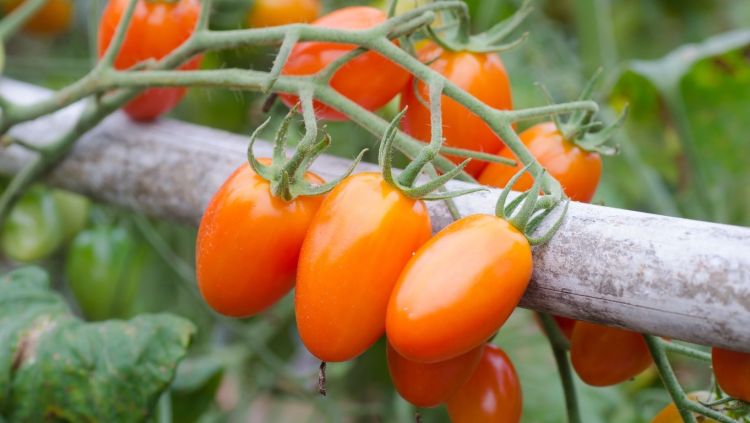Tamarillo, the exotic tomato tree in your pot and garden
Tamarillo is a small fruit tree with fruits that look like tomatoes and is better known as a tomato tree. Originally from Latin America, the tomato tree is widely grown in Australia, China, South Africa and the USA. It belongs to the same family as tomatoes, peppers, eggplants and potatoes, is characterized by rapid growth and reaches a height of 2-5 meters.
Tamarillo has large leaves that give off a strong scent and numerous fragrant white-pink flowers. The fruits of the tomato tree have a characteristic oblong shape and length of about five centimeters weighing about one hundred grams, while their color can be yellow, red or orange depending on the variety. The fruits of the tomato tree, tamarillo, are exotic fruits with significant nutritional value, as they are rich in vitamins and antioxidants.

Which vegetables make a good neighbor with tomatoes – Practical tips in the garden
Under what conditions does tamarillo grow?
Tamarillo thrives in areas with subtropical and Mediterranean climates characterized by mild weather. In this environment, the tomato tree can grow to a life of 10 years, starting its fruiting from the second year and reaching maximum fruit production in the 4th and 5th year. The tomato tree needs enough space to grow and is grown at distances of 2-3 meters between plants.
The tomato tree is sensitive to frost and low winter temperatures, strong winds and summer heat. For planting the tomato tree we prefer light soils, rich in organic matter that have good drainage. The tomato tree can be planted in a pot on our balcony, as long as we provide it in a sunny position protected from strong winds and frost.
If our area is quite cold, for the winter months we can move the pot indoors, placing the tomato tree in a bright place inside the house, with good ventilation and away from radiators.
Blue tomatoes, or anto-tomatoes in your garden – exotic and very healthy

What watering and fertilizing needs does tamarilo have?
Tamarillo has significant needs for watering in order to have good growth and flowering. In spring and autumn we water 2-3 times a week, while in the hot summer months you may need daily watering.
To improve the soil before planting the tomato tree, we incorporate enough organic matter into each pit, either in the form of compost or in the form of well-digested manure, as well as organic fertilizer rich in potassium.
In the first year of tamarillo cultivation, we add in the beginning of spring and in the beginning of summer a biological fertilizer rich in nitrogen, while in the following years we prefer a complete organic fertilizer with high content of potassium.
How is tamarillo pruned and multiplied?
Tamarillo has relatively low pruning requirements. We prune the young seedlings in the first year when they reach one meter, cutting the top shoot to enhance lateral growth. In the following years, it is usually enough to do an annual pruning in early spring as soon as the winter frosts have passed, removing dry and weak shoots, achieving better ventilation and greater exposure to the sun on the leaf surface of the tomato tree.
Caged tomatoes: Double the harvest of your tomatoes without trimming them

Regarding the method of propagation of the tomato tree, we can create new plants from seed, however we prefer the method of propagation with cuttings (parts of shoots) 10-15 cm long that we get from the top vegetation of the tomato tree in the spring and in the spring using light topsoil to fill them.
Note that tomato, pepper and eggplant can be inoculated on the tamaril as they belong to the same family.
What diseases and insects affect tamarillo?
The tomato tree is resistant to diseases and insects in relation to the cultivation of tomatoes, but can be infected with meligra, mealy mildew, fungal fungal disease and various viruses. For the ecological treatment of meligra and floury, we spray as a precaution with a solution of grated soap, while for the mildew we spray with a solution of baking soda.
Sweet Pea – The tiniest tomatoes you’ve ever seen in your pot or garden
When does it ripen and how is tamarillo eaten?
Tamarillo fruits are ready to be cut usually in late summer when they are ripe enough. Avoid eating them raw, as the skin and the outside of the flesh have a bitter taste. The inside of the fruit is extremely tasty and is used in salads giving a unique taste.
Tamarilo fruit is more reminiscent of fruit in taste than vegetable, as it has a special bittersweet taste. It is widely used in jams and compotes, while in some countries the inside of the fruit is mixed with water and sugar to create juices.

And a secret for tamarillo
Tamarillo is considered one of the lost foods of the Incas along with dozens of exotic fruits that were grown in the Andes and that today researchers are trying to locate and restore to cultivation.





















